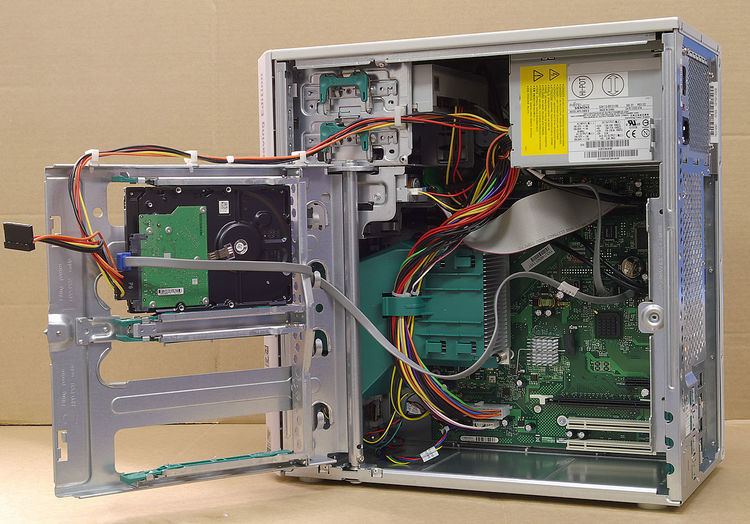 | ||
BTX (for Balanced Technology eXtended) is a form factor for motherboards, originally intended to be the replacement for the aging ATX motherboard form factor in late 2004 and early 2005.
Contents
It was designed to alleviate some of the issues that arose from using newer technologies (which often demand more power and create more heat) on motherboards compliant with the circa 1996 ATX specification. The ATX and BTX standards were both proposed by Intel. However, future development of BTX retail products by Intel was canceled in September 2006 following Intel's decision to refocus on low-power CPUs after suffering scaling and thermal issues with the Pentium 4.
The first company to implement BTX was Gateway Inc, followed by Dell and MPC. Apple's Mac Pro utilizes some elements of the BTX design system as well but is not BTX-compliant, rather using a proprietary form factor.
Enhancements
Pico BTX
Pico BTX is a motherboard form factor that is meant to miniaturize the 12.8 × 10.5 in (325 × 267 mm) BTX standard. Pico BTX motherboards measure 8 × 10.5 in (203 × 267 mm). This is smaller than many current "micro"-sized motherboards, hence the name "pico". These motherboards share a common top half with the other sizes in the BTX line, but support only one or two expansion slots, designed for half-height or riser card applications.
Other smaller BTX sizes include: micro BTX at 10.4 × 10.5 in (264 × 267 mm) and nano BTX at 8.8 × 10.5 in (224 × 267 mm).
Compatibility with ATX products
In the first months of production the ATX and BTX motherboards were so similar that moving a BTX motherboard to an ATX case was possible and vice versa. This was possible because the first BTX motherboards were ATX motherboards turned upside down, except for the component location that really were BTX positioning.
Later the BTX form factor had a big change by turning it into a mirror image of the ATX standard. Since the new motherboard design, both standards are incompatible. Basically BTX motherboards are 'leftside-right' compared to ATX and not upside-down as before: i.e. they are mounted on the opposite side of the case. Some computer cases such as the Cooler Master Series (Stackers) were released to support a varying range of motherboard standards such as ATX, BTX, Mini-ATX and so forth, to ease motherboard upgrade without buying a new case; however, all connector and slot standards are identical, including PCI(e) cards, processors, RAM, hard drives, etc.
BTX power supply units can be exchanged with newer ATX12V units, but not with older ATX power supplies that don't have the extra 4-pin 12V connector, which was introduced with the ATX12V standard.
Reception
The BTX form factor has not been widely adopted despite its improvements over ATX and related standards. As a result, the availability and variety of BTX-compatible components is limited.
One reason for the failure of BTX to gain traction in key markets was the rise of energy-efficient components (CPUs, chipsets and GPUs) which require less power and produce less waste heat, eliminating two of the primary intended benefits of BTX. Another reason was the lack of OEM adopters.
Initially, only Gateway and Dell offered computers with the new format, later HP and Fujitsu-Siemens (now Fujitsu) also offered some BTX-based computers. Most other manufacturers stayed with the ATX standard, and even the handful of manufacturers who did adopt BTX for some products continued to produce the bulk of their machines with the ATX form factor.
